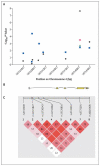Toll-like receptor 3 and geographic atrophy in age-related macular degeneration
- PMID: 18753640
- PMCID: PMC2573951
- DOI: 10.1056/NEJMoa0802437
Toll-like receptor 3 and geographic atrophy in age-related macular degeneration
Erratum in
- N Engl J Med. 2008 Oct 23;359(17):1859
- N Engl J Med. 2009 Jul 23;361(4):431
Abstract
Background: Age-related macular degeneration is the most common cause of irreversible visual impairment in the developed world. Advanced age-related macular degeneration consists of geographic atrophy and choroidal neovascularization. The specific genetic variants that predispose patients to geographic atrophy are largely unknown.
Methods: We tested for an association between the functional toll-like receptor 3 gene (TLR3) variant rs3775291 (involving the substitution of phenylalanine for leucine at amino acid 412) and age-related macular degeneration in Americans of European descent. We also tested for the effect of TLR3 Leu and Phe variants on the viability of human retinal pigment epithelial cells in vitro and on apoptosis of retinal pigment epithelial cells from wild-type mice and Tlr3-knockout (Tlr3(-/-)) mice.
Results: The Phe variant (encoded by the T allele at rs3775291) was associated with protection against geographic atrophy (P=0.005). This association was replicated in two independent case-control series of geographic atrophy (P=5.43x10(-4) and P=0.002). No association was found between TLR3 variants and choroidal neovascularization. A prototypic TLR3 ligand induced apoptosis in a greater fraction of human retinal pigment epithelial cells with the Leu-Leu genotype than those with the Leu-Phe genotype and in a greater fraction of wild-type mice than Tlr3(-/-) mice.
Conclusions: The TLR3 412Phe variant confers protection against geographic atrophy, probably by suppressing the death of retinal pigment epithelial cells. Since double-stranded RNA (dsRNA) can activate TLR3-mediated apoptosis, our results suggest a role of viral dsRNA in the development of geographic atrophy and point to the potential toxic effects of short-interfering-RNA therapies in the eye.
2008 Massachusetts Medical Society
Figures


Comment in
-
Geographic atrophy in age-related macular degeneration and TLR3.N Engl J Med. 2009 May 21;360(21):2251; author reply 2255-6. doi: 10.1056/NEJMc082233. N Engl J Med. 2009. PMID: 19458376 No abstract available.
-
Geographic atrophy in age-related macular degeneration and TLR3.N Engl J Med. 2009 May 21;360(21):2252; author reply 2255-6. N Engl J Med. 2009. PMID: 19469036 No abstract available.
-
Geographic atrophy in age-related macular degeneration and TLR3.N Engl J Med. 2009 May 21;360(21):2254-5; author reply 2255-6. N Engl J Med. 2009. PMID: 19469037 No abstract available.
-
Geographic atrophy in age-related macular degeneration and TLR3.N Engl J Med. 2009 May 21;360(21):2252-4; author reply 2255-6. N Engl J Med. 2009. PMID: 19469038 Free PMC article. No abstract available.
References
-
- Ferris FL, 3rd, Fine SL, Hyman L. Age-related macular degeneration and blindness due to neovascular maculopathy. Arch Ophthalmol. 1984;102:1640–2. - PubMed
-
- Sarks JP, Sarks SH, Killingsworth MC. Evolution of geographic atrophy of the retinal pigment epithelium. Eye. 1988;2(Pt 5):552–77. - PubMed
-
- Yates JR, Sepp T, Matharu BK, et al. Complement C3 variant and the risk of age-related macular degeneration. N Engl J Med. 2007;357:553–61. - PubMed
-
- Cameron DJ, Yang Z, Gibbs D, et al. HTRA1 variant confers similar risks to geographic atrophy and neovascular age-related macular degeneration. Cell cycle. 2007;6:1122–5. - PubMed
Publication types
MeSH terms
Substances
Grants and funding
LinkOut - more resources
Full Text Sources
Other Literature Sources
Medical
Molecular Biology Databases
